Television antennas come in a variety of forms largely dictated by the frequency of the signal
they are designed to receive and by their intended installation location. For television, the
frequency is divided into two major bands: VHF (Very High Frequency) and UHF (Ultra High
frequency). The VHF band covers channel numbers 2 through 13, while UHF covers channels
14 through 51. Note that with digital broadcasting, the channel numbers indicated by the
stations do not have to match the actual broadcast channel (frequency) as they once did
in the days of analog television. Antennas are generally intended to be mounted either indoors
or outdoors.
One of the myths surrounding antennas due to the recent digital broadcast transition is that
different antennas are required for digital broadcasts; this is not the case. Any antenna that
worked well with analog TV should be fine for digital TV (all the channel allocation frequencies
and bandwidths are the same - only the modulation has changed). Even more ridiculous are the
"HDTV" labels; digital standard definition and high definition not only share the same frequency
characteristics, but are modulated identically as well. One significant difference that will be
observed between analog and digital reception is the behavior at low signal levels. Where
reduced signal in analog TVs resulted in increasing levels of viewable noise ("snow") or
"ghosting" (weak offset overlapping image resulting from interference of reflected signals,
a.k.a. "multi-path") but was still watchable, reduced signals in digital television below a
specific threshold will cause freezes, large blocky picture errors, or complete loss. The
advantage of digital TV is that it will maintain a sharp clear picture at a lower signal level
than analog TV.
One thing all TV antennas will need to work effectively is good "line-of-sight" to the
transmitting antenna. If structures or hills block the view of the transmitting antenna from
the receiving antenna, reception will be poor (in fact, the "line-of-sight" from the
transmitting antenna to receiving antenna needs to be at least six feet above the highest
point between the two, assuming that highest point is within a mile of the receiving
antenna).
Indoor Antennas
Classic indoor antennas come in two basic types: "rabbit ears" and "loop". The rabbit ears
(two telescoping metallic rods) are intended to be used for the VHF band, while the loop is
for the UHF band (many antennas combine the two). Other more expensive antennas have variations
on these types and may also incorporate amplification.
To get the best reception on an indoor antenna, there should be a minimum of material between
the antenna and the signal source (transmitting tower). A window is best, but reception can
be obtained through a wall (the fewer, thinner walls, the better). Note that electrical wiring,
conduit or metal pipes, or metal mesh (plaster/stucco) in walls, or aluminum siding can
block signals more than wood, dry wall, or plastic siding. Large metallic objects like
appliances will block signals entirely.
The instructions below are provided as a basic guide for getting started with adjusting antennas
for the best reception. Due to the potential complexities of each situation, it may be necessary
to use minor variations of antenna positions. To gauge the signal strength, many digital TVs,
recording devices, or converters have a mode to add channels manually that provides a signal
strength indicator. This is the easiest way to check the received signal level. Use the
Broadcast Stations menu item to determine the channel/frequency and select that channel in
the device channel selection function. After making an adjustment to the antenna, back away
and observe the signal level; continue adjusting until the best possible signal level is
achieved. In the illustrations, the red arrow indicates the direction to the signal source
(transmitting antenna).
To align rabbit ears, set whatever device will be providing the signal strength
indication to channel 8 (183MHz).
(Why?) Start with the "ears" as close to flat (horizontal) as possible, and
perpendicular to the direction of the signal source.
(Why?) Both ears should be the same length
(Why?) with a tip-to-tip distance of about
32 inches.
(Why?) Incrementally increase the length of both "ears" and check the signal
strength. When the strength peaks and then begins to fall, return the "ears" to
the length of greatest signal strength.
|

|
To align a loop antenna, set whatever device will be providing the signal strength
indication to the weakest channel of interest.
(Why?) Start with the loop vertical and squarely facing the signal source
(Why?) Shift the direction and angle of the loop slightly and check the signal
strength. Select the position that provides the greatest signal strength.
|

|
Outdoor Antennas
Outdoor antennas may be omnidirectional (can receive signals from all directions - typically
disk antennas) or can be directional (receive much better in a specific direction - typically
the classic multi-element aerial or a panel type).
A disk antenna is typically omnidirectional; all that needs to be done is to mount
the antenna where it has visibility to the transmitting antennas. This will be
fine for most stations in this area, but may be marginal for the weakest stations.
Also some may only be for UHF and not work for VHF.
|
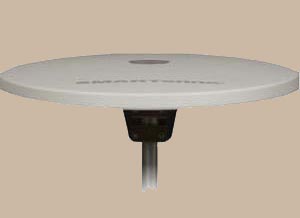
|
Panel type antennas are directional, and should be mounted facing the transmitting
antennas. They typically provide better reception than a disk antenna. Note that
many panel antennas also are only for UHF and may not work for VHF.
|
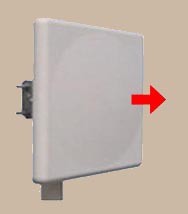
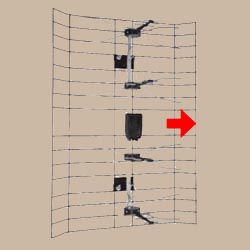
|
Aerial antennas are directional, and the "pointy" end should be directed at the
transmitting antennas. These antennas generally provide the best reception. The
more "elements" the antenna has (rods protruding to the sides), the better the
antenna typically is. Aerial antennas can be for VHF, UHF, or both (the pictured
antenna is VHF/UHF - the longer "elements" are for VHF, the shorter ones are
for UHF).
|
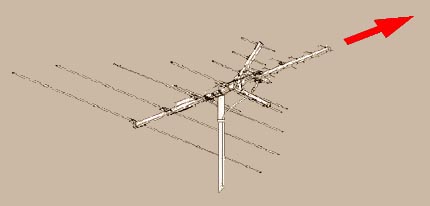
|
Amplifiers
Using an amplifier can help improve reception, but has limitations. If the antenna is not
adequate, and the received signal level is too close to the level of the background noise
(referred to as a low Signal-to-Noise Ratio (SNR)), using an amplifier will not help
because the noise is amplified with the signal; without an adequate SNR, the noise can
produce random freezes, blocky pictures and dropouts. If you can not get any reception
without the amplifier on any channel, the odds are not great that an amplifier will help.
If you can get reception of more powerful stations, but not weaker ones, the odds are good
that an amplifier will help. If you can get reception of all stations with one device, but
loose weaker stations when splitting the connection between multiple devices, an amplifier
will definitely help (or use an amplified splitter).
Where to point the antenna
In this viewing area, all the stations are broadcast from Cheyenne Mountain. Use the series
of photographs below to locate where to point the antenna. (From here, Cheyenne Mountain
is located at 226 degrees from magnetic north.)



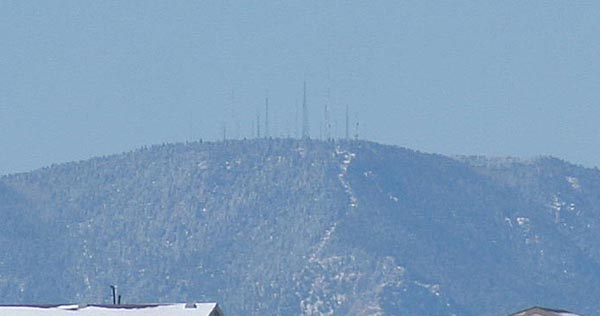
For more information, see the
FCC Digital Television and
AntennaWeb websites.








